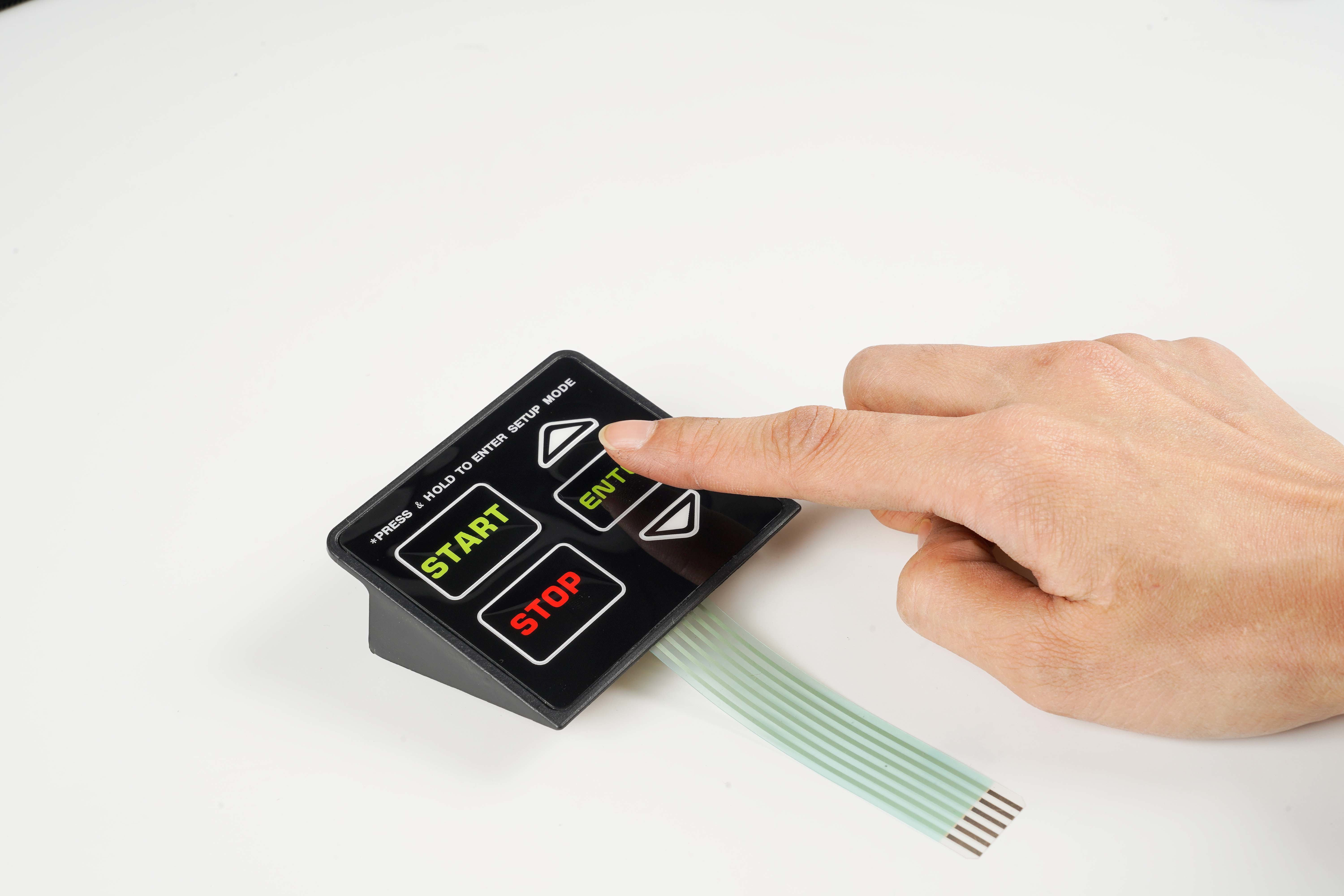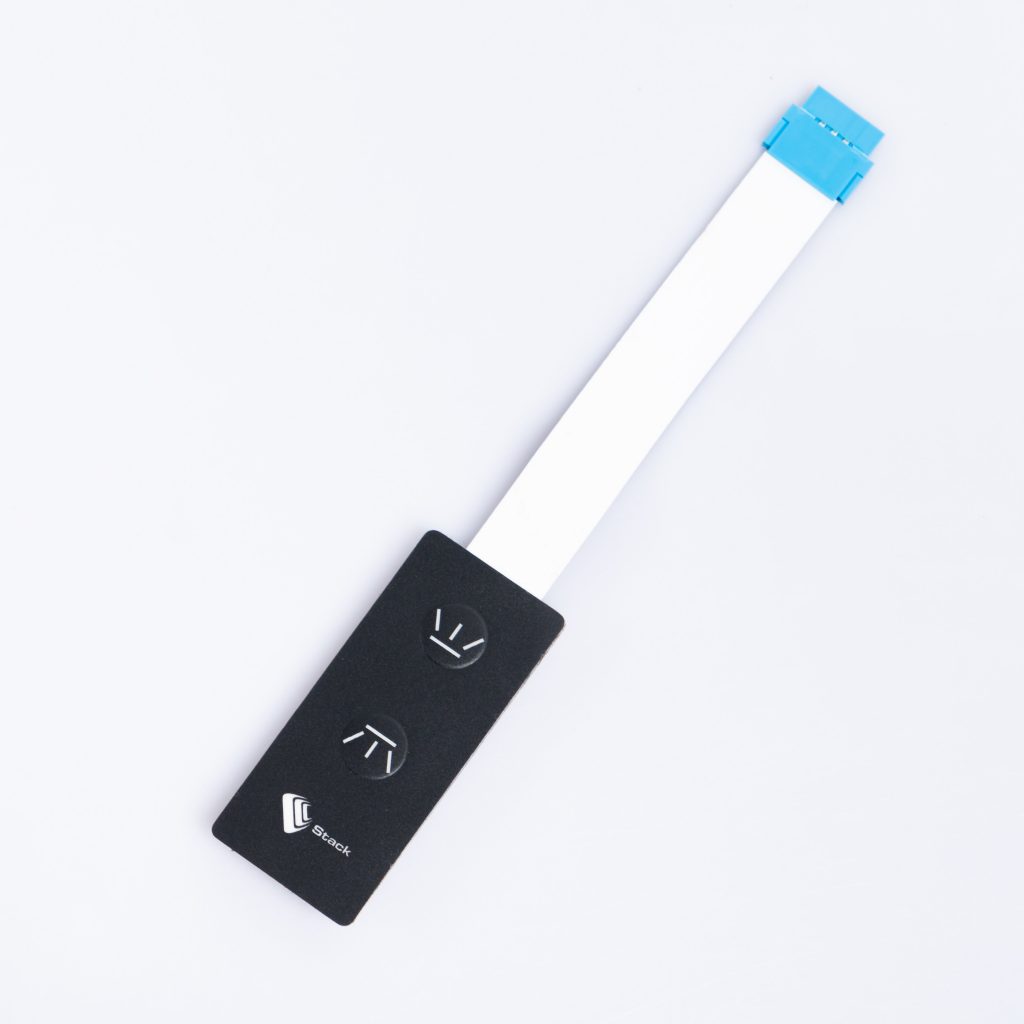Everything About Membrane Switch: A Comprehensive Overview for Beginners
Membrane buttons are necessary components in contemporary electronic devices, supplying an one-of-a-kind interface for customer interaction - membrane switch. Their split building, consisting of overlays and conductive traces, offers capability and toughness. Unlike traditional mechanical buttons, membrane switches offer a sleek style and customizable choices. Recognizing their essential attributes and benefits can transform item design. The details of their application and design considerations necessitate further expedition.
What Is a Membrane Switch?
A membrane button is a sort of electrical switch that includes an adaptable membrane layer layered over a printed circuit board. This design enables a smooth and small user interface, frequently used in different digital tools. Membrane layer switches are commonly found in consumer home appliances, medical devices, and commercial equipment as a result of their longevity and resistance to environmental factors.The construction usually includes several layers, such as graphic overlays and sticky backing, which offer tactile comments and shield the wiring underneath. The operation of a membrane layer switch is started when stress is put on the surface area, finishing an electric circuit.These buttons are valued for their adaptability, making it possible for personalized layouts and published graphics that deal with particular individual interfaces. Their low-profile nature reduces space needs, making them excellent for applications where typical buttons might not fit. In general, membrane buttons supply a useful and aesthetic remedy for modern digital devices.
Trick Elements of Membrane Switches
Membrane switches comprise numerous essential parts that contribute to their performance and performance. The top layer, called the overlay, offers the user interface and is frequently published with graphics or symbols. Below the overlay exists a spacer layer, which divides the conductive aspects and protects against unintended activation. The following important component is the graphic layer, which enhances aesthetics and assures the durability of the design.Conductive traces, commonly made from products like silver or carbon, are printed on the circuit layer. When pressure is put on the overlay, these traces enter into get in touch with, completing the circuit. Additionally, a support layer uses architectural support and can be made from materials such as polyester or polycarbonate. With each other, these elements produce a trustworthy, straightforward user interface appropriate for numerous applications, from household devices to commercial devices. Comprehending these elements is necessary for any person interested in membrane layer switch technology.
How Membrane Changes Job
Recognizing how membrane layer switches function is crucial for appreciating their extensive usage in various devices. A membrane button runs via a series of layers, including a graphic overlay, spacer, and a circuit layer. When stress is used to the overlay, it presses the spacer layer, allowing the circuit layer to make contact and complete an electrical circuit. This activity sends out a signal to the tool, motivating a response, such as switching on a light or triggering a function.Membrane switches over can be made with numerous features, including tactile feedback, backlighting, and customized graphics, improving individual interaction. Their building enables a sealed design, safeguarding the internal components from dust, moisture, and pollutants. This sturdiness makes them appropriate for varied applications, from customer electronic devices to industrial devices. In general, the simplicity and efficiency of membrane switches add to their appeal in modern-day innovation.
Advantages of Membrane Switches Over Mechanical Buttons
While mechanical buttons have actually long been a staple in lots of gadgets, membrane switches deal unique advantages that make them increasingly appealing. One significant advantage is their slim account, permitting more compact layouts and higher flexibility in product growth. Furthermore, membrane switches attribute an uniform surface, which boosts aesthetic appeal and streamlines cleaning, making them suitable for settings where hygiene is critical.Another benefit is their resistance to dirt and wetness. Unlike mechanical buttons, which can be jeopardized by environmental variables, membrane switches give a closed user interface that secures against impurities - membrane switch. Membrane buttons generally have a longer life-span due to fewer relocating components, resulting in enhanced longevity and reliability.Cost-effectiveness is likewise a remarkable benefit, as membrane layer buttons can be produced in bulk with reduced manufacturing expenses. These variables combine to position membrane layer buttons as a useful choice to conventional mechanical alternatives in various applications
Typical Applications of Membrane Layer Switches Over
Membrane switches are commonly made use of in numerous industries, especially in customer electronic devices and industrial control panels. In consumer gadgets, they give a sleek, user-friendly interface, while in industrial setups, they boost durability and functionality. Comprehending these applications highlights the adaptability and usefulness of membrane layer buttons in modern technology.
Consumer Electronics Gadgets
As consumer electronics remain to develop, membrane switches have ended up being a prominent option for a range of gadgets because of their adaptability and smooth layout. These switches are typically discovered in smart devices, tablets, and remotes, where room is limited and appearances issue. Their reduced account and adjustable styles allow producers to create user-friendly user interfaces that boost the general individual experience. Additionally, membrane buttons are usually utilized in home appliances such as microwaves and coffee makers, providing instinctive control alternatives while withstanding moisture and dust. The longevity and integrity of membrane switches make them ideal for daily consumer items, making sure longevity and regular efficiency. In general, their assimilation in customer electronics mirrors a blend of capability and contemporary design.
Industrial Control Panels
The applications of membrane layer switches expand beyond customer electronic devices, finding substantial use in commercial control panels. These buttons are favored for their durability and resistance to rough atmospheres, making them ideal for producing and process control settings. They give a trustworthy interface for drivers to control machinery, display processes, and change setups. Membrane buttons can be customized to fit details functional demands, incorporating attributes like backlighting and tactile feedback, improving individual experience. Their inconspicuous style enables integration right into numerous equipment, while their capability to withstand spills, dust, and severe Our site temperature levels guarantees durability. On the whole, membrane layer buttons add to safe and efficient procedure in commercial applications, showing their flexibility and efficiency popular settings.
Considerations for Designing Membrane Changes
When making membrane layer buttons, selecting the best materials is necessary to assure resilience and performance. Furthermore, comprehending layer arrangement strategies can substantially affect the button's efficiency and customer experience. These factors to consider play a vital duty in developing dependable and effective membrane button layouts.
Product Choice Value
Material selection plays a vital function in the design and functionality of membrane buttons. The selected products straight impact the switch's durability, responsive reaction, and general aesthetic. Trick factors to consider consist of the substrate, which should provide architectural honesty while permitting for versatility, and the graphic official statement overlay, which requires to be immune to wear and ecological aspects. Conductive materials should assure trusted electric performance, while adhesives have to use strong bonding without endangering the button's operation. In addition, compatibility with producing processes and end-user settings is important; materials need to endure varying temperature levels, humidity degrees, and chemical exposure. Inevitably, proper material option not only boosts the membrane switch's efficiency but additionally adds to its longevity and individual complete satisfaction, making it a crucial facet of the style procedure.

Layer Arrangement Methods

Often Asked Concerns
For How Long Do Membrane Changes Generally Last?
Membrane layer buttons typically have a life-span of 1 to 5 million cycles, depending on usage and environmental problems. Aspects such as design quality and operating frequency greatly affect their durability and general efficiency long life.

Can Membrane Changes Be Customized for Details Designs?
Membrane layer switches can undoubtedly be customized to fit particular layouts, permitting diverse shapes, colors, and functionalities. This convenience makes it possible for producers to tailor these buttons to satisfy special aesthetic and functional demands efficiently.
What Products Are Utilized in Membrane Switch Over Construction?
Membrane layer buttons are usually built making use of products such as polyester, polycarbonate, and glue layers. These materials provide resilience, adaptability, and resistance to ecological elements, ensuring the switches function properly in different applications and problems.
Are Membrane Switches Immune or waterproof to Dampness?
Membrane layer buttons can be designed to be moisture-resistant, utilizing specialized layers and materials. Nonetheless, their water resistant capabilities rely on building quality and particular applications, making it necessary to assess requirements for ideal efficiency in different environments.
Exactly How Are Membrane Layer Changes Repaired if Damaged?
Fixing damaged membrane switches over generally involves replacing the influenced layer or circuit. Professionals may also use conductive adhesive or make use of specialized fixing kits, making sure capability is recovered without complete substitute of the whole switch assembly. Unlike typical mechanical buttons, membrane buttons provide a streamlined design and adjustable choices. A membrane switch is a type of electric switch that consists of a flexible membrane layered over a printed circuit board. The procedure of a membrane layer switch is launched when stress is applied to the surface, completing an electric circuit.These buttons are valued for their adaptability, making it possible for custom layouts and i was reading this published graphics that provide to specific customer interfaces. While mechanical buttons have long been a staple in numerous gadgets, membrane layer switches over deal distinctive benefits that make them progressively appealing. Membrane layer switches typically have a longer life expectancy due to less relocating components, resulting in boosted toughness and reliability.Cost-effectiveness is likewise a significant advantage, as membrane buttons can be generated in mass with reduced production prices.